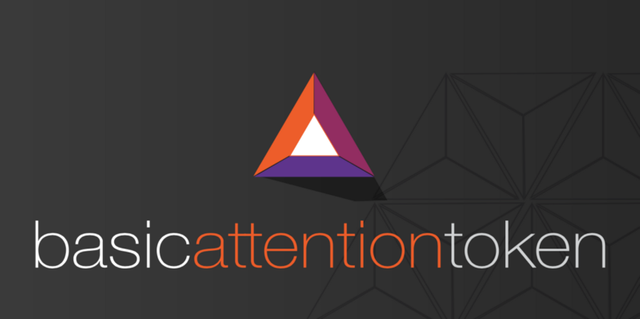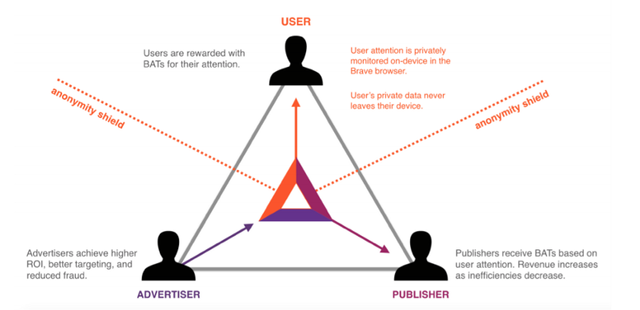Basic Attention Token (BAT) Review

<figure name="e166" id="e166" class="graf graf--figure graf-after--h3">

Author: El Crypto Chapo (www.twitter.com/el_crypto_chapo)
Co-Author: Vitalik Nakamoto (www.twitter.com/VitalikNakamoto)
Quick Overview
- The founder & CEO of BAT created JavaScript and co-founded Mozilla & Firefox
- BAT built their own web browser (Brave), which provides the following benefits:
- Integrated ad & tracking blocker
- Enhanced user privacy
- Faster web page loading times than Chrome, IE, Mozilla, etc
- ~50% less data used by mobile devices from browsing
- Integrated cryptocurrency wallet; users will earn and be rewarded in BAT
- Users can choose to have ad blocker on and you will never see any commercials
- Users can also allow ads and get paid in BAT tokens as a reward
- User privacy is maintained as the browsing data is stored on anonymous blockchain
- Project is disruptive to digital advertising as it provides a win-win-win for all industry participants :
Advertisers achieve better targeting and better back-end feedback on effectiveness of the money they spend
Publishers will recognize higher revenue % of total advertising spend
Users will get paid to consume ads (only when wanted) and the ads they see will be better geared toward their interests
- BAT integrated their tokens into Youtube and recently to Twitch.
- BAT can be used for web-based video games and other applications
- Brave browser already has 1M+ users
A Closer Look
One of the most promising use cases for blockchain technology is eliminating the middleman in a transaction. In nearly every industry, middlemen exist, resulting in inefficient processes, less transparency and higher transactional costs. The ability for blockchain technology to directly connect providers & consumers in a streamlined way leads to a win-win on both sides. The digital advertising landscape has transformed dramatically in the past decade, with more targeted advertising made possible by Google and Facebook. Digital advertisers are willing to pay a premium for ad content on Google and Facebook because of the user data that these companies are able to gather.
The immense amount of data is used to target ads to individuals, thereby making the effectiveness of the advertising exponentially more effective than the “shotgun” approach which has been historically employed. Billions of dollars are pouring into the growing digital advertising space, but who is reaping the benefits of this increased spend? A shocking 99% of the global digital advertising growth revenue was recognized by two companies — Google & Facebook.
With nearly all of the advertising growth worldwide going to these two companies, it becomes painfully obvious that companies are willing to pay more for targeted advertising to their consumers. A successful advertising campaign is measured in incremental pull-through revenue generated per dollar spent on advertising. By better understanding their consumers and targeting ads accordingly, Google & Facebook can outperform every other digital advertising platform by a wide margin. Though better for advertisers (improved metrics) and consumers (ad content is more relevant to the individual), digital advertising through Google and Facebook still has many challenges:
1. User privacy — These companies rely on gathering user information and do so via tracking. Users are not in control of their own data and many times are unaware of the information which is being captured.
2. Browser Performance Impact — Ad content is downloaded unwillingly by users, slowing loading times, increasing data usage & draining device battery life.
3. Poor Advertising Effectiveness Metrics — Current “success” is based on page views/click counts. Difficult for advertisers and publishers to determine ROI on advertising money spent.
4. Malvertisements — Malicious code is embedded in many ads, instilling fear in consumers to click-through on ads that interest them.
In traditional advertising media (television, radio, print media), the cost of advertising is directly proportional to the size of the audience. This metric is measured in viewers, listeners & subscribers. Does this accurately reflect the true value that will be recognized by the advertiser? When you read a magazine, how much time do you spend looking at the ads? Do you view them, read them & truly absorb them or do you just flip right past them to the next section of the magazine? If you haven’t spent any of your time viewing the ad, did the advertiser gain the value they paid for? The actual commodity that advertisers want to pay for isn’t viewers/listeners/subscribers, they are looking for attention from these consumers. Capturing attention from potential consumers is the true goal of advertising. User attention is much more strongly linked to pull-through revenue than the traditional advertising metrics (viewers/listeners/subscribers) and today’s digital advertising metrics (clicks/page views).
Basic Attention Token (BAT) aims to commoditize this coveted user attention, thereby solving many of the current problems in the complex world of digital advertising. The BAT ecosystem is a newly created digital advertising platform where the following benefits can be recognized:
1. Users are in control of their data & privacy is paramount
2. Users are in control of the advertisement content they see
3. Users are compensated for their attention
4. Publishers are paid directly for attracting user attention
5. Advertisers pay directly for the commodity they ultimate desire — user attention
6. Advertisers reduce risk of fraud (malvertising)
7. Advertisers achieve more direct consumer targeting with high quality user data
<figure name="2794" id="2794" class="graf graf--figure graf-after--p">

The BAT token will represent user attention. Tokenizing user attention has the potential to create a much more effective advertising ecosystem and revolutionize the way advertisers, publishers & users interact.
1. Advertisers will transact in BAT to purchase advertising space and user attention
2. Publishers and content creators will receive ad revenue and user contributions in BAT
3. Users will earn and be rewarded in BAT for their attention (“ad revenue sharing”). Users can keep their tokens, contribute to their favorite content providers or spend the tokens on any application accepting BAT
The development team for Basic Attention Token has created an innovating web browser, Brave, which integrates the BAT functionality. The Brave browser already has 1M+ users and is an open-source, privacy-protecting software with integral ad-blocking and tracking-blocking. In the early phases, the usage of BAT will likely be limited to the Brave browser. With that said, the team envisions other more widely-used browsers (Chrome, Mozilla, etc) to use add-ons in the future, allowing for the Basic Attention Token ecosystem to be used across all platforms. This means that while the success of BAT is heavily linked to Brave, the success of the project is not solely dependent upon the mass adoption of the Brave web browser.
This project’s goals of developing and market a widely-used web browser & disrupting a multi-billion dollar growing industry may appear to be lofty and likely unachievable at first glance. Is this another project with a brilliant idea and high hopes, but will ultimately go nowhere? Success appears likely for this team as there are numerous key points that point toward a favorable future for this project.
- Brendan Eich is the founder/CEO. This is the mastermind who created JavaScript & co-founded Mozilla & Firefox. Could you think of a better person to lead this charge?
- The team is attempting to disrupt a very broken industry. All current players in the market are currently suffering in different ways, so all participants are incentivized to support the success of this venture.
- Brendan Eich and the BAT team are comprised of hardcore developers and programmers. They have not yet been focused on marketing this project, so they have gotten to this point by the merits of their technical work. This project has not been hyped, but has instead been built on solid fundamentals.
- There is limited competition with respect to decentralized digital advertising and no other company or project team is anywhere close to where the BAT team is from a product development or community standpoint.
- Recent integration to YouTube and Twitch provide two of the best possible platforms for the BAT use case. Compensation for content providers no longer needs to be based on vague algorithms, but users now have the ability to reward their favorite channels. Previously, the Brave Payments system only allowed users to donate BAT by domain name. These recent integrations are a sign of more partnerships to come for platforms with user-generated content and should lead to increased token utility.
- The Brave browser is already a working product, with the bulk of the functionality already implemented and available today. Download the Brave browser and give it a try — it’s refreshing to browse the web ad-free with increased speed! https://www.brave.com/
In summary, Basic Attention Token is a project that will create a new digital advertising ecosystem where user attention is commoditized & tokenized. The users will benefit via enhanced privacy control, reduced risk of fraudulent advertising, ads which are more applicable to the individual & compensation for their attention. Advertisers will benefit through better targeting, increased visibility to the effectiveness of their ads & reduced advertising cost (higher ROI) by more directly connecting them with their consumers. Publishers will be compensated based on the quality of the content they create and how much user attention is garnered through their ads. This concept revolutionizes the digital advertising cost/pricing model so companies ultimately get what they pay for and publishers are rewarded for the quality of their content.
At the time of this writing, $BAT currently has a market cap of ~$260M with a price of ~$0.26 per BAT token. Current price is 70%+ off the ATH.
In 2017, Facebook generated nearly $40B in ad revenue. Google generated over $95B in ad revenue over the same period. If the Basic Attention Token platform can show growth and become a legitimate player in this space over the coming years, there is a lot of upside with respect to the $BAT token value. Given the tailwinds listed above, Basic Attention Token appears to be extremely undervalued today. This is a project to keep a keen eye on over the next few years as they seek to gain widespread adoption of both the Brave browser and gain buy-in from the major players in the advertising and publishing space. If momentum continues, an exciting future lies ahead for the Basic Attention Token ecosystem.
Disclaimer:
An investment in any strategy involves a high degree of risk. There is the possibility of loss and all investment involves risk including the loss of principal. Any projections, forecasts and estimates are necessarily speculative in nature. Matters they describe are subject to known (and unknown) risks, uncertainties and other unpredictable factors, many of which are beyond my knowledge or control. Any data, calculations, or qualitative statements about the present or past may be erroneous. No representations or warranties are made as to the accuracy, reliability, or completeness of any statements. All information is provided “as is”, without any warranty of any kind. All statements are my personal opinion, unless otherwise specified.
References
2. Intro to BAT